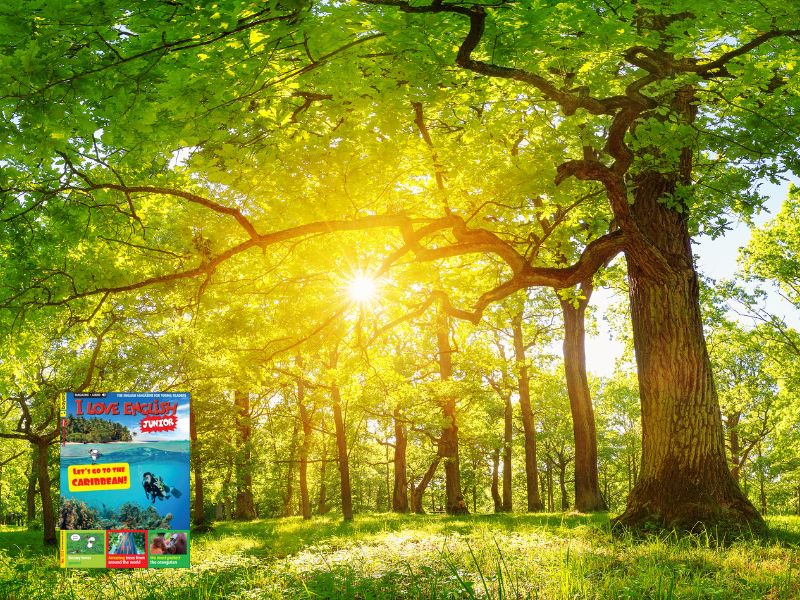Lectura en inglés para niños: Amazing facts about trees and incredible tree species around the world
Datos sorprendentes sobre los árboles del mundo
Publicado por Alba Caraballo, editora de Conmishijos.com
Creado: 1 de junio de 2023 16:06 | Modificado: 9 de abril de 2025 08:22
Te invitamos a leer 10 datos asombrosos sobre los árboles del mundo: Amazing facts about trees and incredible tree species around the world. Una lectura muy divertida e interesante para niños de Primaria, de la mano de la revista para aprender inglés I Love English Junior (mayo 2023, número 123).
Los niños conocerán datos sorprendentes sobre estas aves de presa. Además, aprenderán nuevo vocabulario y practicarán la lectura en inglés.
Ver +: Lecturas para niños en inglés
Amazing facts about trees and incredible tree species around the world: lectura en inglés para niños

1. There are around 60,000 species of trees in the world. Brazil is the country with the greatest number of tree species (around 8,999 varieties). Colombia and Indonesia are home to a large number of native tree species too.
2. Did you know that trees communicate with each other? But not only, they can even share nutrients. This is possible thanks to an underground network (as a special internet!) created by a type of fungi that lives on the roots. The root system sends water and minerals to the leaves. The leaves, in turn, transfer sugar to the roots!
3. Trees help each other in dangerous situations. Some tree species release chemical signals to each other to warn them about threats like insects. Nearby trees recognize the warning and produce a substance which makes their leaves taste bitter so that predators don?t approach.
4. Leaves of trees are not naturally green. A chemical called chlorophyll turns them green when they receive sunshine. When leaves get less sunshine, chlorophyll isn't produced as much, so the green colour fades and the other colours are revealed.
5. Being close to trees make us reduce our stress or anxiety levels and blood pressure. Just looking at them is beneficial to our health. Apparently, hospital patients who can see trees from their rooms tend to heal faster and spend fewer days in the hospital!
6. The Rainbow Eucalyptus tree looks like a work of art. It grows in the rainforests of the Philippines, Papua New Guinea and Indonesia. It grows quickly and typically reaches a height of 60-75 metres! When the tree sheds its bark, it goes different colours: green, blue, pink, red, purple, orange and yellow.
7. The Baobab is the national tree of Madagascar but it also lives in mainland Africa and Australia. The tree?s trunk is hollow in the centre and can store hundreds of litres of water. Its flowers open at dusk - in fact, they open so quickly that you can see them opening!
8. The Banyan is the national tree of India. It is a type of fig tree. The Great Banyan, in India, is the world?s widest tree: it covers 14,500 square metres of land. Banyan trees are very valuable to ecology because their figs are food for many birds, fruit bats, primates and other animals.
9. The Sierra Redwoods, also known as giant sequoias, in California, USA, are the tallest trees on the planet. They can grow up to 100 metres tall. The giant sequoia is an endangered species because only about 80,000 trees remain. The oldest known giant sequoia is around 3,200 years old!
10. The Dragon?s blood tree grows on an island in the Arabian Sea near Yemen. The tree is shaped like a mushroom or an umbrella and has red sap which looks like blood. The tree?s crimson resin is used in some Mediterranean countries as a dye and as a medicine.
Artículos relacionados
Lectura en inglés para niños: 10 amazing facts about platypuses
Te invitamos a leer 10 datos asombrosos sobre los ornitorrincos: 10 amazing facts about platypuses. Una lectura muy divertida e interesante para niños de...
Inglés para niños: 10 amazing facts about eagles
Te invitamos a leer 10 datos asombrosos sobre las águilas: 10 amazing facts about eagles. Una lectura muy divertida e interesante para niños de Primaria, de la...
Inglés para niños: 10 amazing facts about London
Te invitamos a leer 10 datos asombrosos sobre Londres en inglés: 10 amazing facts about London. Una lectura muy divertida e interesante para niños de Primaria, de...
Inglés para niños: 10 amazing facts about butterflies
10 datos sorprendentes sobre las mariposas para que los niños aprendan inglés de forma divertida: 10 amazing facts about butterflies
Inglés para niños: 10 amazing facts about zebras
Te invitamos a leer 10 datos asombrosos sobre las cebras en inglés: 10 amazing facts about the zebras. Una lectura muy entretenida para niños de Primaria, de la...
Inglés para niños: 10 amazing facts about the world's largest and fastest animals
Te invitamos a leer 10 datos asombrosos sobre los animales más grandes y rápidos del mundo en inglés: 10 amazing facts about the world's largest and fastest...
Comentarios
¡Sé el primero en comentar!


















